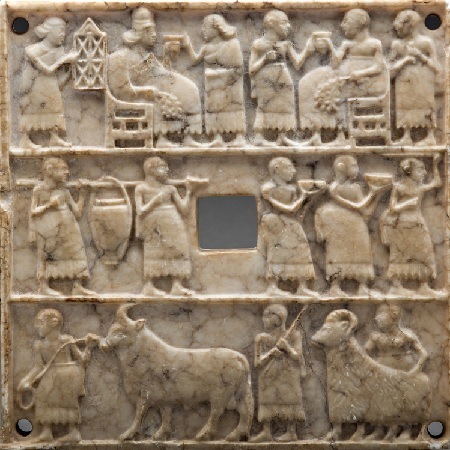A brief introduction to the Sumerians (original) (raw)

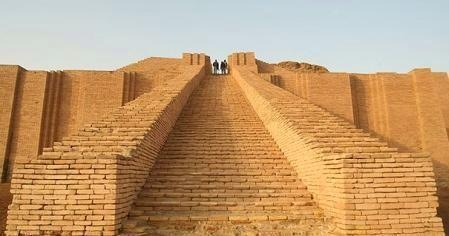
The original "Stairway to Heaven." The grand staircase of the great ziggurat at Ur.
The temple was dedicated to Nanna, the moon god.
The Sumerians were the most extraordinary people who ever lived on the face of the earth. They seemed to come from out of nowhere, and they single-handedly invented civilization when most of the rest of the world was still living in the Stone Age. What’s more, they did it thousands of years before anyone else. In regard to the Sumerians, you will need to revise your concept of ancient in comparison to the "ancient" Greeks, Romans, and Egyptians. The Sumerian civilization was already ancient when it ended in 2004 BC, twenty centuries before Julius Caesar, sixteen centuries before Socrates, and seven centuries before Tutankhamen.
At the dawn of history, the Egyptians were the only people with a civilization comparable to that of the Sumerians (although the Sumerian civilization was much older). There has been some debate on whether they created their civilizations independently or if they cooperated with each other. The historic record seems to indicate that they built their civilizations independently. There is no mention of the Egyptians in the Sumerian archives, or vice-versa, and there is no direct evidence they had a noticeable influence on one another, except for their propensity to build giant pyramids and ziggurats. Though on a modern map they seem to be quite close, they never had any direct contact with each other. Back then, the world
was a much larger place. The only contact between the two great civilizations was through
intermediary traders. (See the page on The Gebel el-Arak Knife.)
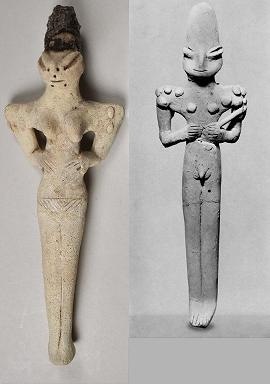
Statuettes from the Ubaid period, the prehistoric era of the Sumerians. This kind of statue, along with the Sumerians' sudden rise to civilization, has caused some people to speculate that the Sumerians were assisted by aliens from outer space.
What’s so remarkable about the Sumerians’ invention of civilization is they did it with so few natural resources. Like the Egyptians, the Sumerians did not have a lot of timber; so it’s somewhat surprising that the world’s first civilizations should arise where there isn't a plentiful supply of wood, which could be used for fuel, the construction of houses, and for many of the utilitarian items needed in daily life. Unlike the Egyptians, however, the Sumerians did not have a lot of stone (imagine Egyptian civilization without its endless supply of stone). Neither did the Sumerians have much mineral wealth. The only thing they had in abundance was mud, but with that mud they built a great civilization. For with that mud they built towering ziggurats, and on that mud they invented writing.
Examples of Sumerian technological inventions include the wheel, copper, bronze, the arch, sailboats, lunar calendars, sundials, saws, chisels, hammers, rivets, sickles, hoes, glue (bitumen), swords and scabbards, harnesses, armor, musical instruments (the lyre and harp), chariots, the kiln, sun-dried and kiln-fired bricks (mixed with straw to give them greater strength), the pottery wheel, printing, plows, metal cooking pots, and (last but not least) beer. There are probably numerous other items that the Sumerians invented for which they haven’t received proper credit. Basically anything that the Sumerians used, which had not already been invented in the Stone Age, they had to invent for themselves.
They also invented civilization in the literal sense of the word. “Civilization” is derived from the Roman word civitas, meaning “city.” The first large cities in the world were Sumerian.

Artist reconstruction of the city of Ur, by Balage Balogh. A Sumerian tablet, written with a kind of worldly discontent, speaks of "the city, where the tumult of man is." In one of the first cities of the world, someone was already complaining about the hustle and bustle of city life.
The Sumerians also invented the more fundamental aspects of civilization: writing, arithmetic, geometry, monumental architecture, irrigation systems and large scale farming (mono-crops), sewage systems, schools, dictionaries, literature, realistic human portraiture, business accounting, the division of labor, and professional armies.
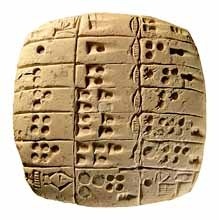
The Sumerian achievements in mathematics are particularly impressive considering the fact that they used the cumbersome sexagesimal number system, based on the number 60, rather than the simpler decimal system (base 10) that we use today. Sumerian mathematics is why we still divide a circle into 360 degrees. The above tablet from Shuruppak is dated in the 27th century BC. It is the oldest known mathematical text. It's a table of computations showing the areas of six rectangles where the length is 60 times greater than the width. The tablet didn't have a practical purpose. It's an example of pure mathematics for its own sake.
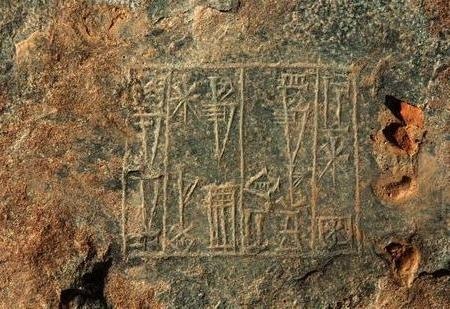
Inscription carved in stone: "Ur-Namma, the king of Ur, he who built the temple of Nanna" refers to the great ziggurat at Ur. When this inscription was written, Ur-Namma was just the king of Ur. He had not yet become the king of both Sumer and Akkad.
The necessity of having to irrigate large tracts of non-arable land seems to be what first compelled the Sumerians to invent their modern society. This required a division of labor under the direction of a central authority (government). It also necessitated a means to pay for the project (taxation, i.e., “donations” of grain, sheep, cattle, dry goods, etc.) and a method to record these payments, which required the invention of writing. The land had to be allotted to different citizens, the water rights managed, and the surplus food distributed to the people.
Once a large labor force was mobilized, construction on a monumental scale soon followed (such as palaces, great temples, and city walls), along with the manufacture of the other necessities of civilization (tools, clothing, weapons, luxury goods, artistic works, and so on). The early administrative systems were centered at the temples, each ruled by a high priest. Later, when the city-states became more powerful and competitive, the government was controlled by a king (lugal, meaning “man-great”) who could also command large armies.
The Sumerians’ single-handed invention of civilization, their remarkable achievements in science, and their lasting influence on the modern world, is all the more extraordinary
when you consider the fact that Sumer, even at its widest extent, was smaller than the
state of Connecticut.
Sumerian civilization lasted for 2,000 years, which is almost twice as long as the Romans.
Sumerian kings modeled themselves on the ideal of a shepherd. The "shepherd kings" were the guardians and protectors of their flocks, the people.They were crucial to the success
of Sumer. You cannot understand the Sumerian civilization until you understand the
shepherd kings. See The Shepherd Kings on this website.
Sumerian plaque from the city of Girsu. Top: The king and queen are attended by servants.
Middle: Servants bring bowls of food and a large vat of beer. Bottom: A bull and a ram are
brought forward, either for sacrifice, or for the feast. Early Dynastic period, circa 2400 BC.
See some close ups. The queen in this picture is the ruling monarch of the kingdom, not her husband. See An Unknown Sumerian Queen. Sumerian queens were quite active in the political and religious affairs of the nation. Also see Another Sumerian Queen, Pu-abi, and other Sumerian Queens.
The common people (and the women) were much better off in Sumer than in the rest of Mesopotamia (and in the rest of the world). That’s because the Sumerians were a small enclave population isolated by their unique language. Their language made them feel separate and different than everybody else in Mesopotamia. Their small population tended to unify them against all others because they were always in danger of being overwhelmed by their neighbors. Life was cheap in the rest of Mesopotamia, with its vast populations that spoke the same or similar languages. Life was more dear in Sumer. Sumerian men and women were cognizant of their self-worth, so they expected their leaders to treat them right. The Sumerians led the world in the formation of human rights. See the page about The Shepherd Kings,
 ki-en-gi (Sumer)
ki-en-gi (Sumer)
Technically, it is Sumer, not "Sumeria." Sumeria is a modern literary word. It’s not known exactly what the Sumerians called themselves. “Sumer” is a corruption of the Akkadian word Shumeru. The signs for Sumer are written as ki-en-gi. Ki means “land,” en means “lord,” and gi means "noble." Sumer is the “Land of Noble Lords.”
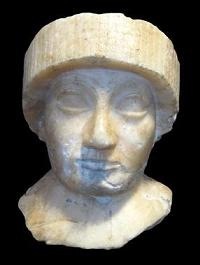
Gudea, the ruler of Lagash. His crown is a shepherd's hat.
Sumerian civilization arose in the fertile region of Mesopotamia between the Tigris and Euphrates rivers in the 5th millennium BC (the word Mesopotamia means “between
the rivers”). Because the Sumerians seemed to have appeared so suddenly on the scene, and because their language is unrelated to other languages of the region (or to any language in the world, then or now) it was originally believed that they were foreign invaders who subjugated the indigenous people already living there. This, however, seems unlikely. It was very difficult for conquerors to impose their language on a native people, and it’s doubtful that the Sumerians could last for thousands of years, through every kind of vicissitude, if they had forced their civilization on an unwilling population.
The Sumerians were probably a small group of hunter/gatherers who decided to settle in this region and become farmers. No one knows where they came from. Theories range from India, Caucasia, Iran, Africa, Turkistan, Tibet (?!), you name it. After years of academic debate, no definitive conclusion has been reached. However, it seems the Sumerians were distinct from the Semitic neighbors that surrounded them (the Akkadians, Elamites (Iranians), Gutians, Hamazi, etc.). It's highly improbable that the Sumerians were ethnically the same as their neighbors but spoke a language that is completely different. Not only was their language different, but their statues and portraits suggest the Sumerians were Caucasians, who originated from the area around the Caspian Sea. The Semites, on the other hand, originated from the Arab Peninsula. See Who were the Sumerians?
Remarkably, the Sumerians were later able to maintain their ethno-cultural identity during two centuries of Akkadian domination (2350 – 2150 BC) after they were conquered by Sargon the Great. During that time it would have been so easy for the Sumerians to be assimilated, to “blend back in,” if they were like their neighbors. Instead, they regained their independence and began the Neo-Sumerian Revival, the ultimate expression of Sumerian civilization.
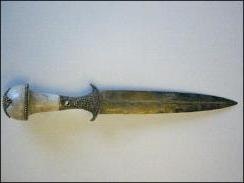
At first there was very little conflict between the Sumerian city-states. As they became larger and more powerful, their rivalry intensified and they often resorted to civil war to settle their differences. The wars were fought for territory and for the control of water rights. The most
famous conflict involved the cities of Umma and Lagash in a contest for possession of the Guedena, the fertile plain that lay between them. This conflict lasted for many generations. The many civil wars fought between the different city-states, too numerous to recount here, make Sumerian history similar to the history of the rest of the world.
Also see War: Umma and Lagash on this website. This is the Sumerian version of the
Hundred Years War.

Map of Mesopotamia, showing Sumer, Akkad, Elam and Gutium. Enlarge.
Not only did the Sumerians have to contend with each other, they also had to deal with the Akkadians. Akkad was the region located northwest of Sumer. The histories of Sumer and Akkad are inextricably tied together. The relationship was sometimes symbiotic, sometimes bloody. They spoke different languages, but through the centuries developed a kind of bilingualism, using the same (Sumerian) sign system and exchanging many "loan words" between them. They shared many cultural and religious values, and they benefited from their mutual trade. At other times they were locked in bloody combat, each seeking domination and control of the other. The “King of Kish,” named for a city in Akkad, became the traditional title of any king who ruled both Sumer and Akkad. The title meant "The King of Kings," and it was claimed by many Sumerians and Akkadians during their long history together. In the words of The King List, a Babylonian record of the dynasties of the region, “the kingship was taken” from Kish, then returned to Kish many different times (the kingship could also be carried to a foreign land after an invasion). Fortunately, the Sumerians and the Akkadians never waged “total war” against each other. They never tried to destroy each other in wars of extermination, or to enslave the populations. Instead, the losing side simply became a vassal state of the winning side. The losers also had to pay taxes (tribute) to the victors. Sometimes the Akkadians were in the ascendancy, sometimes the Sumerians. Thus their history continued for hundreds of years.
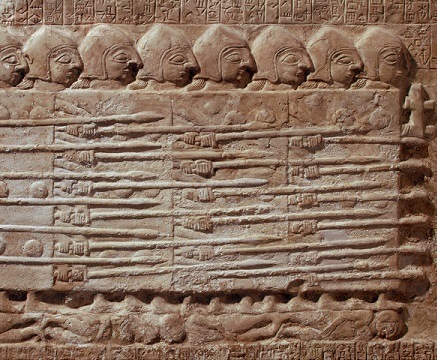
Sumerian soldiers trampling over the bodies of their enemies. Detail from Eannatum's Vulture Stele. Sumerian soldiers were the best soldiers in Mesopotamia. They had to be,
if Sumer was to survive. The Sumerians invented the modern, professional army, where the soldiers are identically armed and equipped, as provided by the state, rather than individual warriors bringing their own weapons to the battlefield. They attack in a disciplined formation. This isn't the disorganized mob of individual combatants that is typical of the more primitive forms of warfare.
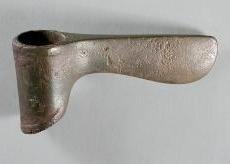 A typical Sumerian battleaxe.
A typical Sumerian battleaxe.
Sumer and Akkad not only had to contend with each other, they also had to deal with the Gutians and the Elamites, their foreign enemies to the north and northeast. The Gutians were nomadic tribesmen from the Zagros Mountains. They were barbarian warriors who didn't want to govern an empire; they were far more interested in looting and sacking cities. The Elamites were a bit more civilized (though still barbarians in the eyes of the Sumerians) who originated in the area now known as Iran. They often conquered parts of Sumer and Akkad, and they would later be instrumental in the final destruction of Sumerian civilization. The many wars in this region, between the Sumerians, Akkadians, Gutians, and Elamites, along with the Hamazi and others, prompted the writer of The King List to ask, “Then who was the king? Who was not the king?"
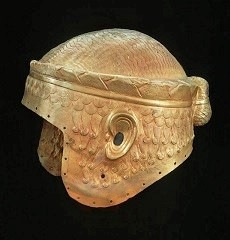 Gold helmet worn by a Sumerian King of Kish.
Gold helmet worn by a Sumerian King of Kish.
In 2350 BC the Sumerians were conquered by Sargon the Great, the Akkadian king who went on to conquer all of Mesopotamia. He defeated the united armies of Sumer in two
pitched battles and captured Lugalzagesi, the Sumerian king who had united (or conquered)
all of Sumer and earned the title of “King of Kish.” Sargon brought the captured Lugalzagesi to the city of Nippur in a neck stock. The Akkadians continued to rule Sumer for the next two centuries. Though Sumer was now a vassal state, it was not treated with undue severity because Akkadians and Sumerians shared many of the same cultural and religious values. For instance, although the Akkadian language became the lingua franca of Mesopotamia,
it was written with the Sumerian sign system. Nonetheless, the Sumerians were no longer in control of their own destiny. Two hundred years is a long time to be a subject nation (about as long as America is old) so it's somewhat surprising that the Sumerians never lost their core identity, their sense of self.
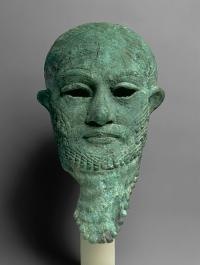 Ur-Namma. King of Ur. King of Sumer and Akkad.
Ur-Namma. King of Ur. King of Sumer and Akkad.
In 2150 BC the Akkadian Empire was destroyed by the Gutians, who also conquered many parts of Sumer. The Sumerians rose up in rebellion under the leadership of Utu-hengal, the king whose city of Uruk was also to be destroyed by the Gutians. Thus the Sumerians’ desire for independence, which had been smoldering beneath the surface for 200 years, was again rekindled. Utu-hengal defeated the Gutians and captured their king, Tirigan. Utu-hengal died seven years later (under mysterious circumstances). The Sumerian battle standard was then passed to Ur-Namma, the king of Ur. He went on to gain more victories against the Gutians. He also united the Sumerian cities into a single nation and he later reconquered Akkad. So once again the nations were united, except this time the roles were reversed; now the Sumerians were the rulers and the Akkadians were the vassals. Like a phoenix, Sumer had risen from the ashes. Now began the Neo-Sumerian Revival, the apex of Sumerian civilization.
The most important kings of the Neo-Sumerian Revival were Gudea, Ur-Namma, and his son Shulgi. The histories of Gudea and Ur-Namma are given elsewhere on this website. Shulgi began his reign with a punitive expedition against Gutium after his father was killed in combat in yet another battle with the Gutians. For the next twenty years he reigned in relative peace. At some point during his reign he stopped calling himself “The King of Sumer and Akkad,” the title his father used, and began to use the appellation of "King of the Four Quarters [of the world]." This was the title used by some Akkadian kings to proclaim their divinity and their dominion over an earthly empire. It suggests that Shulgi began to have the same ambitions. The second half of his reign is marked by several wars with foreign enemies, which necessitated the building of a defensive wall around the borders. Despite this, he gave the Sumerian people 47 years of unparalleled prosperity and he also continued the artistic renaissance that had begun with the reign of Gudea.
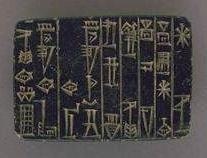 Shulgi tablet dedicated to the goddess Inanna.
Shulgi tablet dedicated to the goddess Inanna.
After the reigns of his successors, Amar-Suen and Shu-Suen, things started to fall apart. First there was drought, then famine. Amorite tribesmen from the land of Martu started migrating from the west in overwhelming numbers. The Gutians were attacking from the north, and the Elamites were menacing the east. Ibbi-Suen, the last king of Ur-Namma’s dynasty, was besieged on all sides. He appealed for help from Ishbi-erra, the king of Isin. Ishbi-erra kept promising assistance that he never delivered. He took twenty talents of silver for desperately needed grain supplies, then kept the money and the grain for himself. As it turns out, he had his own designs on the throne of Sumer. Then in the ultimate betrayal, while Ibbi-Suen was fighting the enemies of Sumer in the north, Ishbi-erra switched alliances, leaving Ibbi-Suen outflanked in the south.
The end came quickly, and catastrophically, in 2004 BC. All the cities of Sumer were sacked and plundered by the Gutians and the Elamites. Ibbi-Suen, the last of the Sumerian kings, was placed in a neck stock and taken to the Elamite capital. He was later executed.
At the time, despite the totality of their defeat, the Sumerians probably didn’t realize that the show was finally over. They had been conquered several times before, but they had always risen again to their former glory. This time, there will not be a Sumerian resurrection.
A period of internecine warfare followed the Fall of Sumer as local lords battled for regional supremacy. Amorites from the north migrated south in overwhelming numbers. Eventually the Akkadians/Amorites gained the ascendancy. The few surviving Sumerians were assimilated into the new kingdoms. The Sumerians were no longer a distinct and independent people. After 1800 BC, Sumerian ceased to be a spoken language.
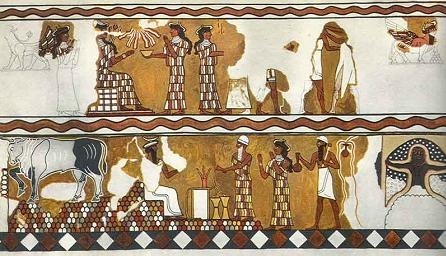
Mural from the Amorite city of Mari, circa 1800 BC. The details of the painting are given in the Images section. The painting is typically Sumerian in its subject matter and appearance (except for the clothes). The picture shows the continuing influence of Sumerian civilization two centuries after it was destroyed.
Southern Mesopotamia later became known as Babylon. The Babylonians considered themselves to be the inheritors of the Sumerian civilization. They adopted Sumerian history as their own. They worshiped many of the same gods (though under different names), continued many Sumerian cultural traditions, and they still used the Sumerian sign system for the language of religion and the court.
After several hundred years, the Babylonian Empire was destroyed in history’s endless cycle of the rise and fall of civilizations. With the final collapse of the Babylonian Empire, all memory of the Sumerians disappeared. The modern world didn't even know about the Sumerians until the late 19th century AD, when archaeological expeditions started unearthing thousands of Sumerian tablets. At first the tablets were thought to be Babylonian or Assyrian because no one had ever heard of the Sumerians. Now, after a century of scholarly research, a portrait of the Sumerians has finally emerged from the dim shadows of the ancient past.
Their extraordinary civilization has once again been resurrected.
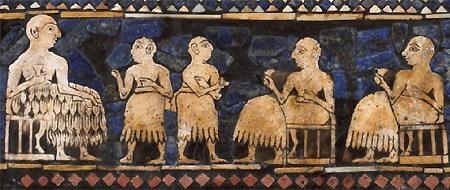
The king on the Standard of Ur.
